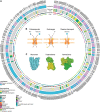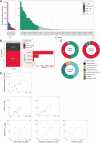An Overview of Cell-Based Assay Platforms for the Solute Carrier Family of Transporters
- PMID: 34447313
- PMCID: PMC8383457
- DOI: 10.3389/fphar.2021.722889
An Overview of Cell-Based Assay Platforms for the Solute Carrier Family of Transporters
Abstract
The solute carrier (SLC) superfamily represents the biggest family of transporters with important roles in health and disease. Despite being attractive and druggable targets, the majority of SLCs remains understudied. One major hurdle in research on SLCs is the lack of tools, such as cell-based assays to investigate their biological role and for drug discovery. Another challenge is the disperse and anecdotal information on assay strategies that are suitable for SLCs. This review provides a comprehensive overview of state-of-the-art cellular assay technologies for SLC research and discusses relevant SLC characteristics enabling the choice of an optimal assay technology. The Innovative Medicines Initiative consortium RESOLUTE intends to accelerate research on SLCs by providing the scientific community with high-quality reagents, assay technologies and data sets, and to ultimately unlock SLCs for drug discovery.
Keywords: SLC; cell-based assay; chemical screening; drug discovery; solute carrier; transporters.
Copyright © 2021 Dvorak, Wiedmer, Ingles-Prieto, Altermatt, Batoulis, Bärenz, Bender, Digles, Dürrenberger, Heitman, IJzerman, Kell, Kickinger, Körzö, Leippe, Licher, Manolova, Rizzetto, Sassone, Scarabottolo, Schlessinger, Schneider, Sijben, Steck, Sundström, Tremolada, Wilhelm, Wright Muelas, Zindel, Steppan and Superti-Furga.
Conflict of interest statement
Research of the RESOLUTE consortium is in the precompetitive space. Authors PA, FD, AS, HS, MW are employed by Vifor. HB and EB are employed by Bayer. DZ was employed by Bayer during the manuscript preparation. TL and FB are employed by Sanofi. RR, FS, LS and ST are employed by Axxam. CS is employed by Pfizer. The remaining authors declare that the research was conducted in the absence of any commercial or financial relationships that could be constructed as a potential conflict of interest.
Figures












References
-
- Al-Khawaja A., Haugaard A. S., Marek A., Löffler R., Thiesen L., Santiveri M., et al. (2018). Pharmacological Characterization of [3H] ATPCA as a Substrate for Studying the Functional Role of the Betaine/GABA Transporter 1 and the Creatine Transporter. ACS Chem. Neurosci. 9, 545–554. 10.1021/acschemneuro.7b00351 - DOI - PubMed
-
- Al-Khawaja A., Petersen J. G., Damgaard M., Jensen M. H., Vogensen S. B., Lie M. E. K., et al. (2014). Pharmacological Identification of a Guanidine-Containing β-Alanine Analogue with Low Micromolar Potency and Selectivity for the Betaine/GABA Transporter 1 (BGT1). Neurochem. Res. 39, 1988–1996. 10.1007/s11064-014-1336-9 - DOI - PubMed
Publication types
Grants and funding
LinkOut - more resources
Full Text Sources

